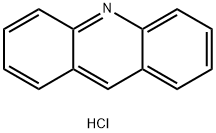ACRIFLAVINE
Synonym(s):3,6-Diamino-10-methylacridinium chloride mixt. with 3,6-diaminoacridine (proflavine);Euflavine;Trypaflavine Neutral
- CAS NO.:8048-52-0
- Empirical Formula: C27H25ClN6
- Molecular Weight: 468.98
- MDL number: MFCD00064307
- EINECS: 999-999-2
- SAFETY DATA SHEET (SDS)
- Update Date: 2025-12-16 16:15:04

What is ACRIFLAVINE?
Chemical properties
Acriflavine hydrochloride is deep orange to brownish-red powder
The Uses of ACRIFLAVINE
Acriflavine is used in applications for dual fluorescence analysis of cellular DNA and protein simultaneously.
The Uses of ACRIFLAVINE
Fluorescent label for high molecular weight RNA
Safety Profile
Poison by subcutaneous route. Questionable carcinogen with experimental tumorigenic data. Human mutation data reported. A topical antiseptic used in the treatment of gonorrhea. When heated to decomposition it emits very toxic fumes of NOx and Cl-. See also 3,6-DIAMINO-10 METHYLACRIDINIUM CHLORIDE.
Purification Methods
Treat acriflavin twice with freshly precipitated AgOH to remove proflavine, then recrystallise it from absolute methanol [Wen & Hsu J Phys Chem 66 1353 1962]. [Beilstein 22 III/IV 218.]
Properties of ACRIFLAVINE
| Melting point: | 179-181 °C |
| Boiling point: | 612.69°C (rough estimate) |
| Density | 1.0933 (rough estimate) |
| refractive index | 1.6000 (estimate) |
| storage temp. | Store at -20°C |
| solubility | H2O: soluble0.33g/mL (lit.)(lit.) |
| form | Powder |
| color | Deep orange to brownish-red |
| Merck | 14,123 |
| CAS DataBase Reference | 8048-52-0(CAS DataBase Reference) |
| EPA Substance Registry System | Xanthacridinum (8048-52-0) |
Safety information for ACRIFLAVINE
| Signal word | Warning |
| Pictogram(s) |
 Exclamation Mark Irritant GHS07 |
| GHS Hazard Statements |
H302:Acute toxicity,oral H315:Skin corrosion/irritation H319:Serious eye damage/eye irritation H335:Specific target organ toxicity, single exposure;Respiratory tract irritation |
| Precautionary Statement Codes |
P261:Avoid breathing dust/fume/gas/mist/vapours/spray. P264:Wash hands thoroughly after handling. P264:Wash skin thouroughly after handling. P270:Do not eat, drink or smoke when using this product. P301+P312:IF SWALLOWED: call a POISON CENTER or doctor/physician IF you feel unwell. P302+P352:IF ON SKIN: wash with plenty of soap and water. P305+P351+P338:IF IN EYES: Rinse cautiously with water for several minutes. Remove contact lenses, if present and easy to do. Continuerinsing. |
Computed Descriptors for ACRIFLAVINE
ACRIFLAVINE manufacturer
JSK Chemicals
3Y
Phone:+91-9879767984
Whatsapp: +91-9879767970
product: Acriflavine neutral 8048-52-0 99%
New Products
Indole Methyl Resin tert-butyl 9-methoxy-3-azaspiro[5.5]undecane-3-carboxylate Boc-His(Boc)-OH 2-CTC Resin 4-Chloro-7-tosy1-7Hpyrrolo[2,3-d]pyrimidine 5,7-Dibromo-1H-indole 2,5-dichloro-N-hydroxy-4,6-dimethylpyridine-3-carboximidamide 2,2-Dimethoxy-7-azaspiro[3.5]nonane hydrochloride 4-chloromethyl-5-methyl-1,3-dioxol-2-one (DMDO-Cl) R-2-BENZYLOXY PROPIONIC ACID 1,1’-CARBONYLDIIMIDAZOLE 1,1’-CARBONYLDI (1,2-4 TRIAZOLE) N-METHYL INDAZOLE-3-CARBOXYLIC ACID 4-((2-hydroxyethyl)thio)benzoic acid 1-(TERT-BUTOXYCARBONYL)-2-PYRROLIDINONE Methyl 6-methylnicotinate 3-Pyridineacrylic acid tert-Butyl carbazate TETRAHYDRO-2H-PYRAN-3-OL 2-((4-morpholinophenylamino) (methylthio) methylene) malononitrile 3-(4-morpholinophenylamino)-5-amino-1H-pyrazole-4-carbonitrile 2,4-dihydroxybenzaldehyde 1,3-Diethyl-1,3-Diphenylurea Methyl 2-methylquinoline-6-carboxylateRelated products of tetrahydrofuran








You may like
-
 8045-52-0 99%View Details
8045-52-0 99%View Details
8045-52-0 -
 Acriflavine Neutral for molecular biology CAS 8048-52-0View Details
Acriflavine Neutral for molecular biology CAS 8048-52-0View Details
8048-52-0 -
 Euflavine 97.00% CAS 8048-52-0View Details
Euflavine 97.00% CAS 8048-52-0View Details
8048-52-0 -
 Powder Acriflavin, Neutral For Molecular BiologyView Details
Powder Acriflavin, Neutral For Molecular BiologyView Details
8048-52-0 -
 Acriflavine Neutral BP cas no 8048-52-0View Details
Acriflavine Neutral BP cas no 8048-52-0View Details
8048-52-0 -
 AcriflavineView Details
AcriflavineView Details
65589-70-0 -
 ACRIFLAVIN NEUTRALView Details
ACRIFLAVIN NEUTRALView Details
8048-52-0 -
 Acriflavine Neutral ( Extra Pure ) Qty. :- 25 Kgs. Price: 14,000/- Per Kg. + 18% Gst ExtraView Details
Acriflavine Neutral ( Extra Pure ) Qty. :- 25 Kgs. Price: 14,000/- Per Kg. + 18% Gst ExtraView Details
8048-52-0
Statement: All products displayed on this website are only used for non medical purposes such as industrial applications or scientific research, and cannot be used for clinical diagnosis or treatment of humans or animals. They are not medicinal or edible.
